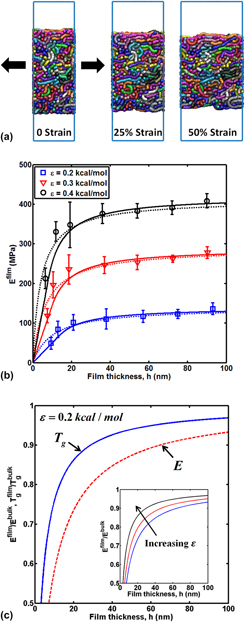Crossref Citations
This article has been cited by the following publications. This list is generated based on data provided by
Crossref.
Kang, Chengjun
Ramakrishna, Shivaprakash N.
Nelson, Adrienne
Cremmel, Clement V. M.
vom Stein, Helena
Spencer, Nicholas D.
Isa, Lucio
and
Benetti, Edmondo M.
2015.
Ultrathin, freestanding, stimuli-responsive, porous membranes from polymer hydrogel-brushes.
Nanoscale,
Vol. 7,
Issue. 30,
p.
13017.
Xia, Wenjie
Hsu, David D.
and
Keten, Sinan
2015.
Molecular Weight Effects on the Glass Transition and Confinement Behavior of Polymer Thin Films.
Macromolecular Rapid Communications,
Vol. 36,
Issue. 15,
p.
1422.
Askar, Shadid
Evans, Christopher M.
and
Torkelson, John M.
2015.
Residual stress relaxation and stiffness in spin-coated polymer films: Characterization by ellipsometry and fluorescence.
Polymer,
Vol. 76,
Issue. ,
p.
113.
Tang, Shan
Li, Ying
Kam Liu, Wing
Hu, Ning
He Peng, Xiang
and
Guo, Zaoyang
2015.
Tensile Stress-Driven Surface Wrinkles on Cylindrical Core–Shell Soft Solids.
Journal of Applied Mechanics,
Vol. 82,
Issue. 12,
Xia, Wenjie
and
Keten, Sinan
2015.
Interfacial stiffening of polymer thin films under nanoconfinement.
Extreme Mechanics Letters,
Vol. 4,
Issue. ,
p.
89.
Shao, Chen
and
Keten, Sinan
2015.
Stiffness Enhancement in Nacre-Inspired Nanocomposites due to Nanoconfinement.
Scientific Reports,
Vol. 5,
Issue. 1,
Askar, Shadid
and
Torkelson, John M.
2016.
Stiffness of thin, supported polystyrene films: Free-surface, substrate, and confinement effects characterized via self-referencing fluorescence.
Polymer,
Vol. 99,
Issue. ,
p.
417.
Xia, Wenjie
Song, Jake
Hsu, David D.
and
Keten, Sinan
2016.
Understanding the Interfacial Mechanical Response of Nanoscale Polymer Thin Films via Nanoindentation.
Macromolecules,
Vol. 49,
Issue. 10,
p.
3810.
Firpo, Giuseppe
and
Valbusa, Ugo
2016.
Nanostructured Polymer Membranes.
p.
293.
Hsu, David D.
Xia, Wenjie
Song, Jake
and
Keten, Sinan
2016.
Glass-Transition and Side-Chain Dynamics in Thin Films: Explaining Dissimilar Free Surface Effects for Polystyrene vs Poly(methyl methacrylate).
ACS Macro Letters,
Vol. 5,
Issue. 4,
p.
481.
Liu, Ning
Hong, Jiawang
Zeng, Xiaowei
Pidaparti, Ramana
and
Wang, Xianqiao
2017.
Fracture mechanisms in multilayer phosphorene assemblies: from brittle to ductile.
Physical Chemistry Chemical Physics,
Vol. 19,
Issue. 20,
p.
13083.
Espinosa-Loza, Francisco
Stadermann, Michael
Aracne-Ruddle, Chantel
Casey, Rebecca
Miller, Philip
and
Whitesides, Russel
2017.
Modeling the mechanical properties of ultra-thin polymer films.
High Power Laser Science and Engineering,
Vol. 5,
Issue. ,
Zhang, Min
Askar, Shadid
Torkelson, John M.
and
Brinson, L. Catherine
2017.
Stiffness Gradients in Glassy Polymer Model Nanocomposites: Comparisons of Quantitative Characterization by Fluorescence Spectroscopy and Atomic Force Microscopy.
Macromolecules,
Vol. 50,
Issue. 14,
p.
5447.
Vogt, Bryan D.
2018.
Mechanical and viscoelastic properties of confined amorphous polymers.
Journal of Polymer Science Part B: Polymer Physics,
Vol. 56,
Issue. 1,
p.
9.
Liu, Ning
Becton, Mathew
Zhang, Liuyang
Tang, Keke
and
Wang, Xianqiao
2019.
Mechanical anisotropy of two-dimensional metamaterials: a computational study.
Nanoscale Advances,
Vol. 1,
Issue. 8,
p.
2891.
Garay, Raúl O.
Del Rosso, Pablo G.
Romagnoli, Maria J.
Almassio, Marcela F.
and
Schvval, Ana Belén
2019.
Photoactive thin films of terphenylene-based amorphous polymers. Synthesis, electrooptical properties, and role of photoquenching and inner filter effects in the chemosensing of nitroaromatics.
Journal of Photochemistry and Photobiology A: Chemistry,
Vol. 384,
Issue. ,
p.
112016.
Xia, Wenjie
and
Lan, Tian
2019.
Interfacial Dynamics Governs the Mechanical Properties of Glassy Polymer Thin Films.
Macromolecules,
Vol. 52,
Issue. 17,
p.
6547.
Phan, Anh D.
and
Schweizer, Kenneth S.
2019.
Theory of the spatial transfer of interface-nucleated changes of dynamical constraints and its consequences in glass-forming films.
The Journal of Chemical Physics,
Vol. 150,
Issue. 4,
Yao, Xue
Wang, Yaru
Lang, Xingyou
Zhu, Yongfu
and
Jiang, Qing
2019.
Raising glass transition temperature of polymer nanofilms as a function of negative interface energy.
Physical Chemistry Chemical Physics,
Vol. 21,
Issue. 9,
p.
5224.
Kwon, Taejin
and
Sung, Bong June
2020.
Confinement effects on the mechanical heterogeneity of polymer fiber glasses.
Physical Review E,
Vol. 102,
Issue. 5,
